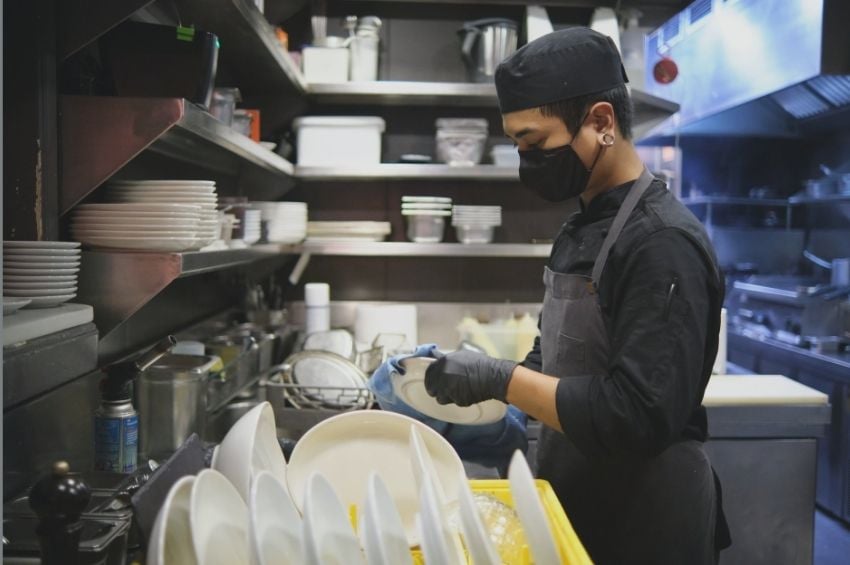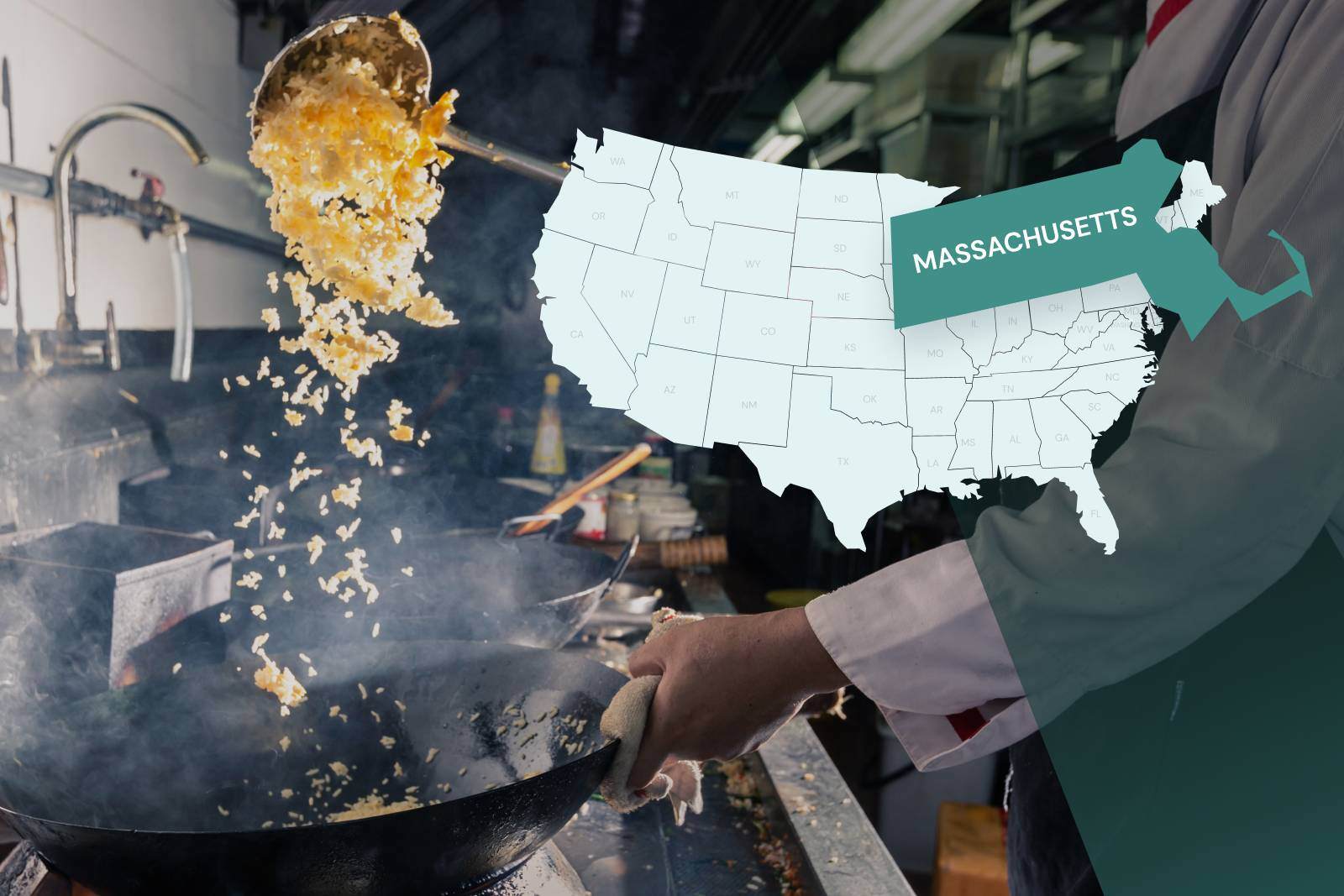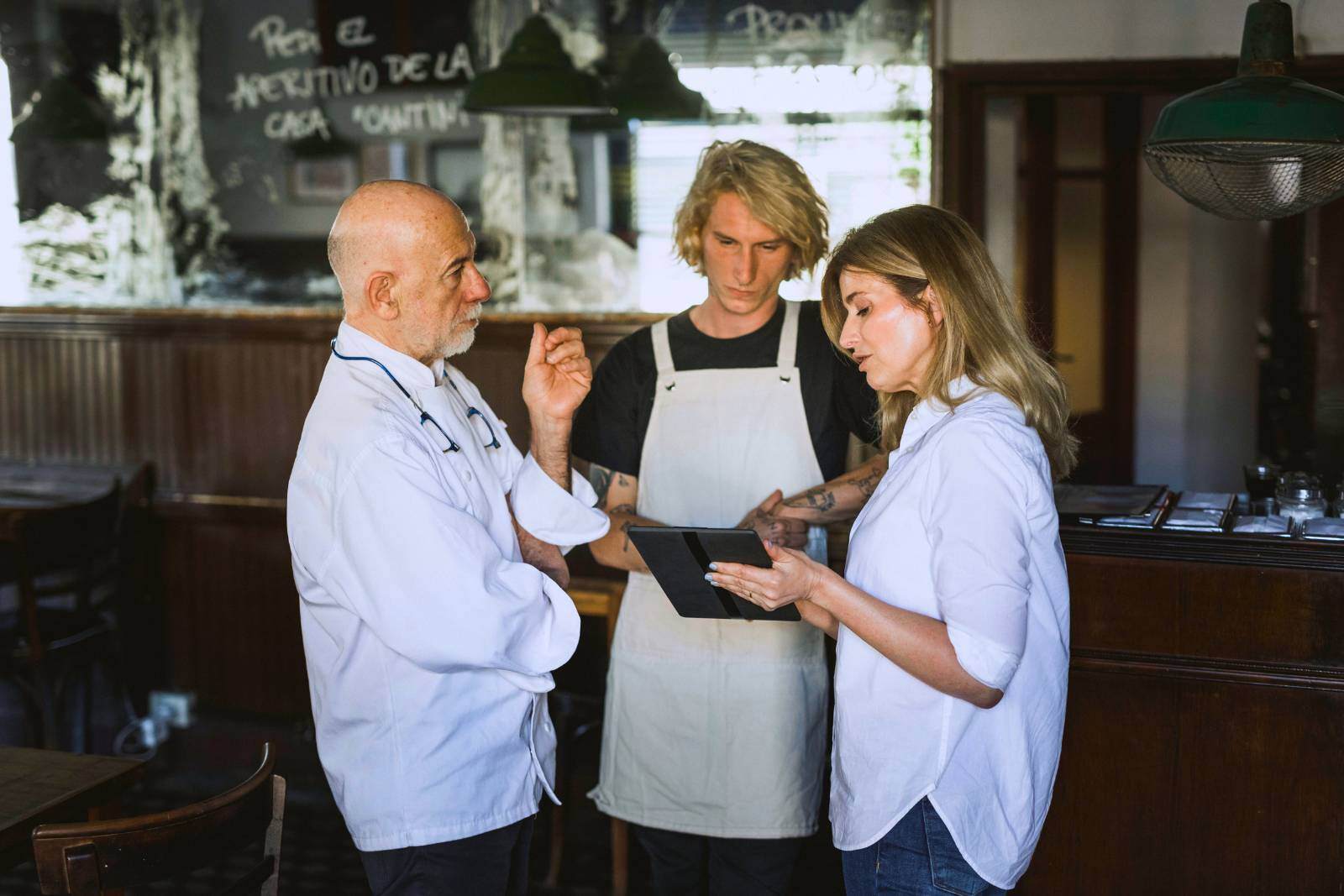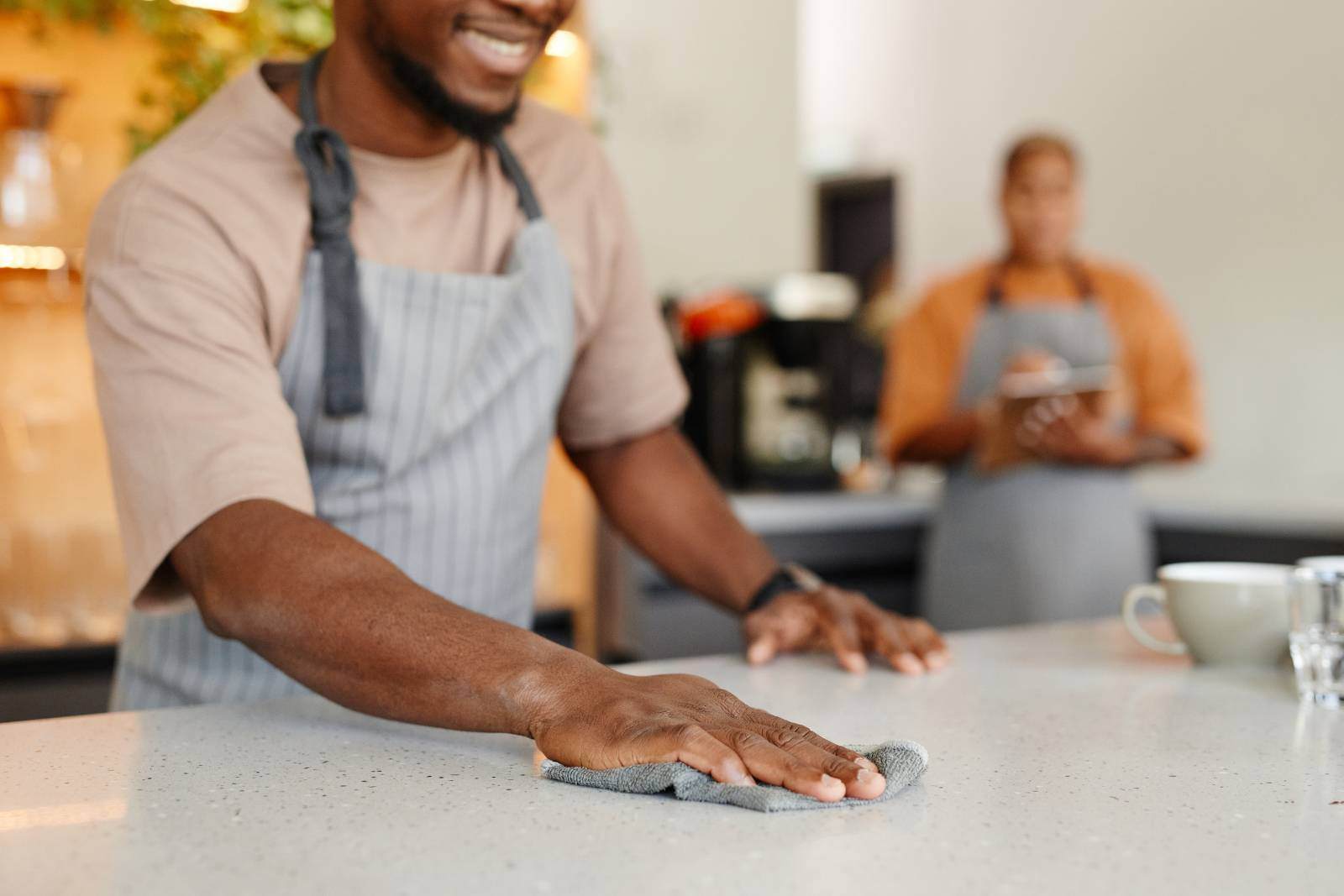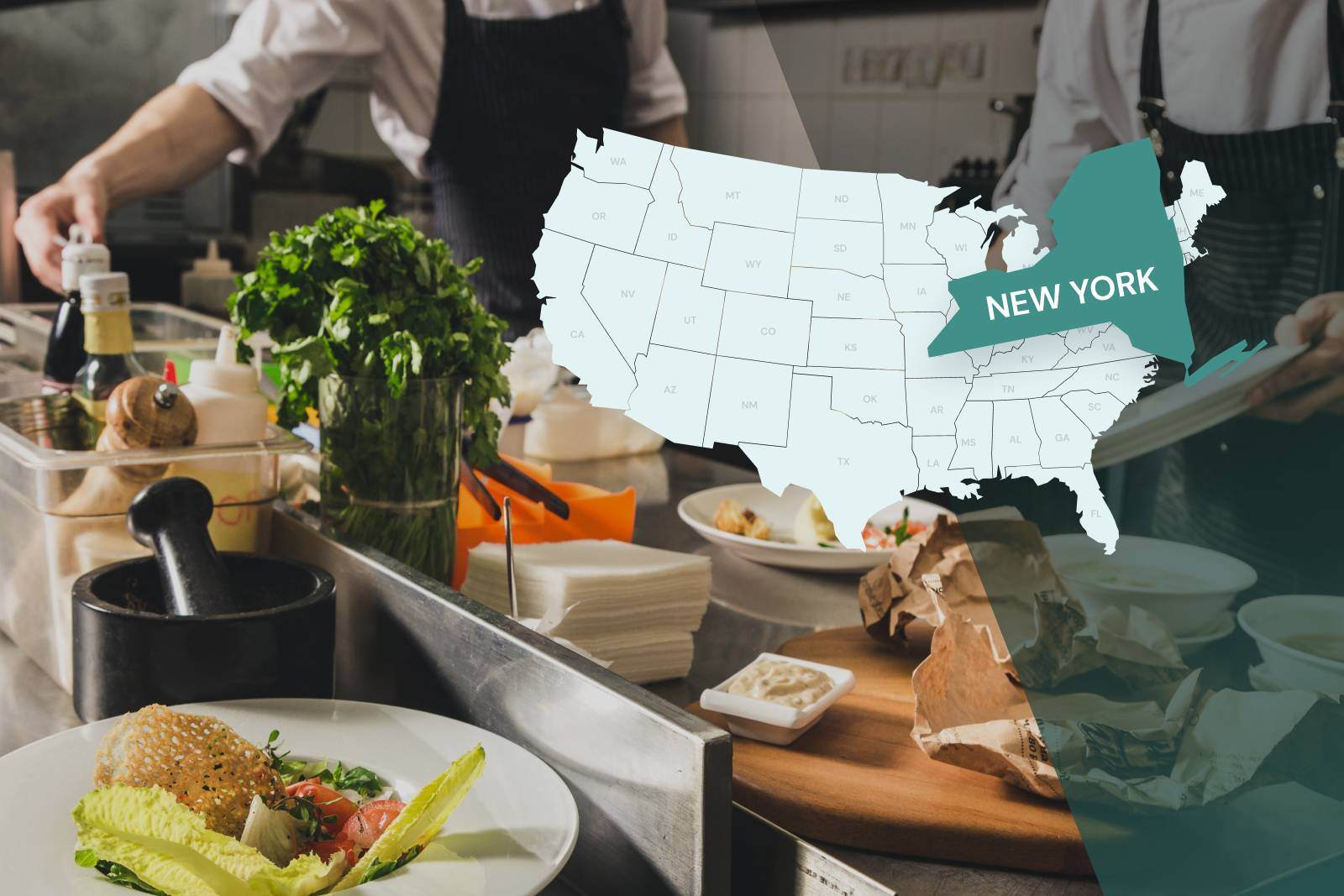While the terms “cleaning, sanitizing, and disinfecting” are regularly used interchangeably, there are distinct differences that matter, especially in a commercial kitchen. Just because something looks clean doesn’t mean it’s sanitary, and that difference can be the cause of spreading (potentially deadly) foodborne illness in your area–something no foodservice establishment wants.
Aside from the reputational hit, any business found liable for spreading foodborne illness also faces lost revenue from closure, fines and potential legal fees, increased insurance premiums, and the additional cost of follow-up inspections, retraining staff, and crisis PR efforts.
Training your team to understand the differences between cleaning, sanitizing, and disinfecting empowers everyone to use the right approach–and right products–in the right situations, maintaining a safe foodservice operation.
So, don your aprons and come with us into the cleaning supply closet, where everything is safely stored and clearly labeled. We’ll have to keep doing it all the old-fashioned way until we invent self-cleaning kitchens.
Cleaning: what it means and how to do it right
Sanitizing: what it means and how to do it right
Disinfecting: what it means and how to do it right
Keeping your kitchen in compliance
Cleaning: what it means and how to do it right
We all think we know when something’s clean, right? But there are authorities on cleanliness who reveal what cannot be seen by the naked eye. The Centers for Disease Control (CDC), for example, defines cleaning as using soap or detergent and water to physically remove germs, dirt, and impurities from surfaces or objects.1
Cleaning is the first step in keeping any space in operational shape because you want to remove that first layer of grime before you can truly sanitize or disinfect critical food-contact surfaces.
Some of the impurities you regularly find in a kitchen–like grease, oils, or other food proteins–can actually prevent sanitizers from making physical contact with the surface they’re meant to sanitize.
That means regular cleaning is essential and shows us why merely protecting the food in your kitchen isn't enough. Wiping down a counter with a rag might remove visible contaminants that could get into food, but it doesn’t kill the most harmful bacteria or viruses that lurk on surfaces for hours or even days.
Those pathogens cause foodborne illness and can spread other viruses, like norovirus, from sick staff. In fact, a recent report from the CDC found that most food-related illnesses from dining out came from sick staff, not from contaminated produce or questionable kitchens as expected.2
We’ll come back to this in the following two sections!
How to keep your kitchen and dining area clean
That doesn’t mean cleaning isn’t still important; it’s the base layer you need for sanitizing and disinfecting to be their most effective. Regular cleaning prevents buildup, which extends the life of equipment and helps prevent pests. You should immediately clean any spills and regularly clean everything else according to an established schedule.
Some areas will only need occasional cleaning–think light fixtures or curtains in the dining room. Others will need near-constant cleaning during lunch and dinner rush or cleaning after every shift. That includes wiping down countertops and equipment, sweeping and mopping, and cleaning all food contact surfaces first with warm, soapy water.
Cleaning also falls in the category of “tidying up,” which helps prevent cross-contamination and other kitchen mishaps.
Sanitizing: what it means and how to do it right
Once you’ve cleaned, it’s time to take the next step for food contact surfaces: sanitizing.
Sanitizing works by lowering the number of germs on surfaces or objects to a safe level, as defined by public health standards or requirements. A kitchen can be clean but not sanitary, and it’s the latter that health inspectors look for.
Sanitizing is important because of its specific focus on reducing the number of microorganisms to safe levels, which is a crucial part of keeping kitchens safe from foodborne illness. It kills bacteria, but not viruses (we’ll cover that when we talk about disinfecting).
After cleaning food contact surfaces, you or your team should sanitize them. These surfaces include food preparation areas, countertops, cutting boards, equipment, utensils, and other tools. You should use separate preparation areas, equipment, and tools to help prevent cross-contamination and cross contact. These tactics help eliminate the possibility of some foodborne illness and reduce the chance of an allergic reaction.
How to effectively sanitize your kitchen
Here is where another authority enters the conversation: the Environmental Protection Agency, or EPA. The EPA is the entity in the U.S. that regulates products that sanitize and disinfect.
Disinfectants “are subject to more rigorous EPA testing requirements and must clear a higher bar for effectiveness than surface sanitizing products.” Still, many products are registered with the EPA as both because they’ve been tested with both methods.3
With that in mind, you’ll want to look for products approved by the EPA for sanitizing food contact surfaces–and you should always use products intended for use in commercial kitchens. Everyone on staff should follow the manufacturer’s instructions on the label and wear gloves while using any cleaning products.
If you don’t follow the instructions, you risk leaving food contact surfaces contaminated with pathogens, and not wearing gloves can lead to skin irritation or chemical burns. One common mistake is not letting a product sit for long enough to sanitize a particular area because of the pressure to keep up with the demands of a busy kitchen.
The quick and dirty guide to cleaning and sanitizing
Need to see what this looks like in a few quick steps? Have this checklist handy for your staff to reference when needed:
-
Remove obvious food, dirt, and debris: Sweep the floor, brush crumbs off a table, scrape down a cutting board, etc.
-
Wash: Use soap or detergent and warm water; this removes buildup from grease or oils and allows a sanitizer to physically reach the surface you need to sanitize
-
Rinse: Use clean water to rinse anything you have just washed
-
Sanitize: Follow manufacturer instructions on a product approved by the EPA for sanitizing in a commercial kitchen; be sure to use the right amount, use the right tools (and/or wear gloves), and let it sit for the right amount of time
-
Wipe down: Remove any excess product with a clean, dry cloth.
Disinfecting: what it means and how to do it right
Finally, disinfecting uses chemicals to kill any remaining germs on surfaces or objects, further lowering the risk of spreading disease. Disinfecting kills viruses–like the norovirus–that jump from person to person and are the leading cause of illness from dining out in the U.S., as we highlighted earlier.
While you want to sanitize any food contact surfaces, you want to disinfect all surfaces that staff and customers come into contact with in your establishment. Viruses can unfortunately linger for much longer than we’d like to think they can, causing illness long after the infected person has moved through an area.
For this reason, it’s vital that any sick staff stays home from work and that anyone who starts to experience symptoms of illness while working goes home immediately.
How to effectively disinfect your establishment
Train your staff to disinfect any high-touch surfaces in the kitchen and dining area as part of your cleaning schedule. High-touch surfaces include:
-
Doorknobs, handrails, hostess stands
-
Menus, ordering kiosks, tablets, and
-
Bathroom surfaces from doorknobs to countertops and faucets.
Ideally, you must clean these surfaces between every use, but we know it’s not exactly practical to have someone wiping down a doorknob after every single person walks through during the dinner rush. Try to have high-touch surfaces cleaned and disinfected at least hourly to help reduce the spread of germs that cause illness.
As with sanitizing, you want to find products intended for this exact use, rated for commercial kitchens, and approved by the EPA. Everyone on the team should know how to read the product labels and follow the instructions for proper use and storage.
Keeping your kitchen in compliance
The final key to success is knowing your local health department regulations around cleaning, sanitizing, and disinfecting–and how they differ from the FDA Food Code (here’s Kentucky’s, for example). Your health inspector will hold you and your establishment to these standards, and they should be the foundation of all employee onboarding and training.
As for training, start with basic hygiene practices and then move on to offering more comprehensive training from there. You can also hold mini “stand-up” training sessions to keep information fresh in your team’s minds.
Staying clean
Maintaining a clean, safe kitchen is critical to continued business success. While we like to think we can see when something is clean, that doesn’t mean it’s sanitary or has been properly disinfected.
Understanding the difference between these terms keeps your staff on top of their game, keeping your kitchen running smoothly even at the busiest times. Thorough education and training means it’s muscle memory when it comes time to clean and sanitize a food preparation area before moving on to the next dish.
That’s a recipe for serving up success.
Editor's Note: This post was originally published in September 2022 and has been updated for accuracy and to provide further resources to foodservice professionals.
Sources

